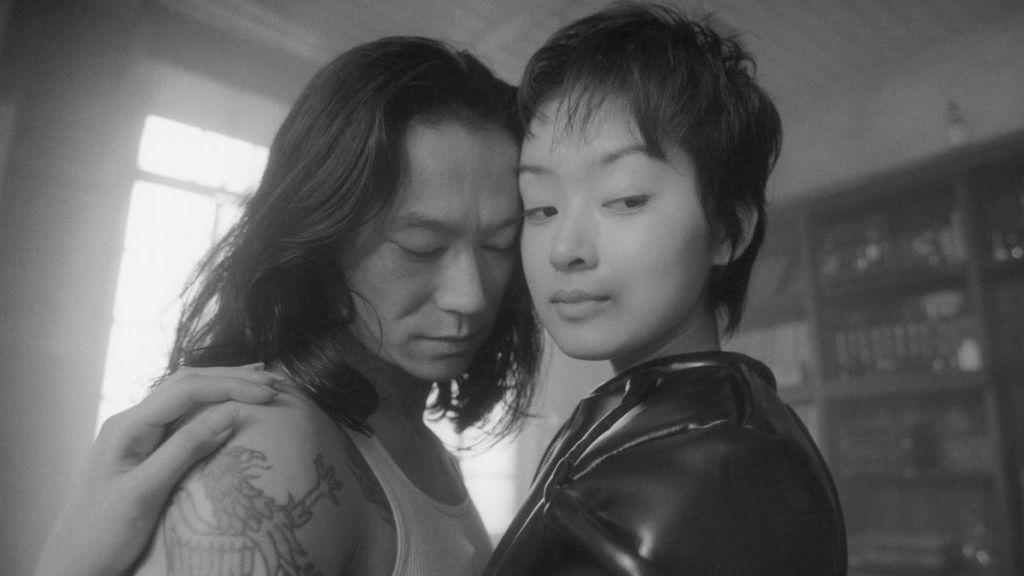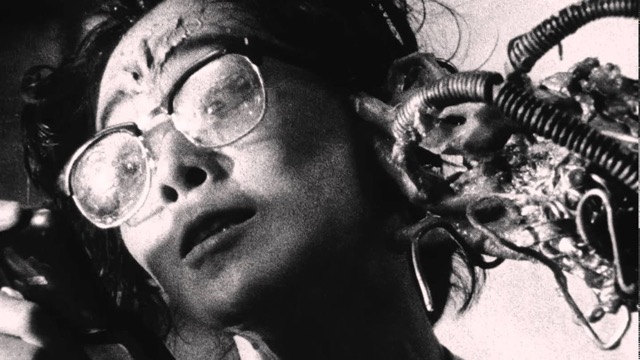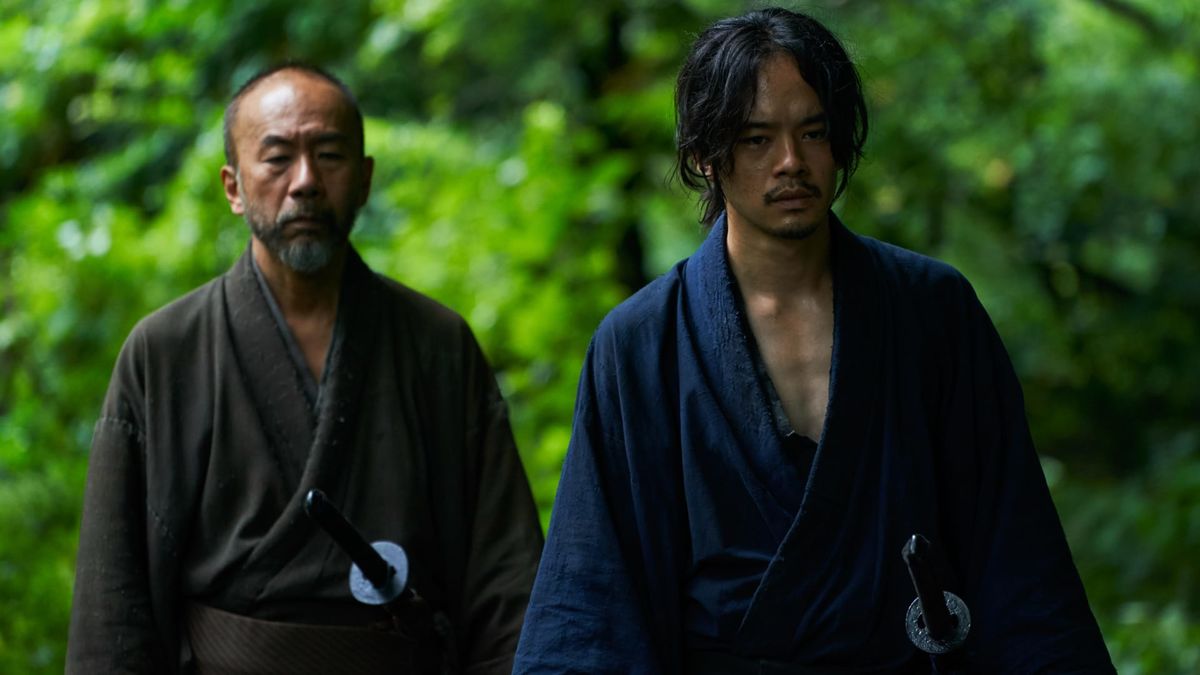Shin’ya Tsukamoto is a Japanese filmmaker best known for pioneering Japanese cinema’s cyberpunk and body horror genres. His most iconic film, Tetsuo: The Iron Man, is a seminal work that exemplifies his penchant for melding the organic with the mechanical, a nightmarish vision of human metamorphosis into machinery.
Tsukamoto’s films often grapple with the interface between the human body, technology, and urban life. He frequently employs kinetic camerawork, harsh metallic soundscapes, and a monochromatic aesthetic to amplify the dystopian nature of his worlds. The transformative and destructive powers of machinery are evident in Tetsuo II: Body Hammer, where human frailty is pitted against the onslaught of industrialisation. Yet, it’s not merely the physical transformation that fascinates Tsukamoto but the psychological repercussions of it. His characters frequently undergo intense emotional and mental journeys, driven to the brink by their surroundings and circumstances, as seen in Kotoko and Bullet Ballet.
Furthermore, Tsukamoto has a unique approach to filmmaking that often blurs the lines between the real and the surreal, the organic and the mechanical, the human and the monstrous. His settings, often urban landscapes, become characters in their own right, teeming with life, danger, and unpredictability. For example, in Tokyo Fist, the city becomes a battleground for personal and societal conflicts, mirroring the internal struggles of its protagonists. Tsukamoto’s visual style, marked by frenetic editing, gritty textures, and jarring sound design, serves to further immerse the viewer into his distinctive universe.

Shin’ya Tsukamoto (1960 – -)
Calculated Films
- Tetsuo: The Iron Man (1989)
Similar Filmmakers
- Alejandro Jodorowsky
- Darren Aronofsky
- David Cronenberg
- David Lynch
- E. Elias Merhige
- Gakuryu Ishii
- Gaspar Noé
- Hideaki Anno
- Katsuhiro Otomo
- Kiyoshi Kurosawa
- Lars von Trier
- Panos Cosmatos
- Shozin Fukui
- Sion Sono
- Takashi Miike
- Tetsuya Nakashima
- Toshiharu Ikeda
- Tsui Hark



Shin’ya Tsukamoto’s Top 5 Films Ranked
1. Tetsuo: The Iron Man (1989)
Genre: Body Horror, Surrealism, Cyberpunk, Experimental, Techno-Horror

2. Vital (2004)
Genre: Psychological Drama

3. Fires on the Plain (2014)
Genre: War, Survival

4. Bullet Ballet (1998)
Genre: Crime, Psychological Drama, Neo-Noir

5. Tokyo Fist (1995)
Genre: Sports, Drama

Shin’ya Tsukamoto: Themes and Style
Themes:
- Urban Decay and Anxiety: Tsukamoto often sets his stories in urban landscapes that exude chaos, mechanical frenzy, and societal fragmentation. His characters frequently confront the crushing weight of city life, which can lead to personal transformations—both mental and physical.
- Body Horror and Transformation: One of the most prominent themes in Tsukamoto’s work is the grotesque metamorphosis of the human body. Films like “Tetsuo: The Iron Man” delve into the melding of flesh and metal, symbolising the erosion of humanity in a technological world.
- Isolation and Identity: Many of his characters grapple with feelings of isolation, whether it’s due to societal pressures, personal trauma, or their metamorphosing bodies. This isolation often results in a quest for identity or meaning.
- Violence and Brutality: Tsukamoto doesn’t avoid presenting visceral and graphic violence. However, this isn’t gratuitous; it usually serves as a vehicle to communicate deeper psychological or emotional struggles.
Styles:
- Kinetic Camera Movements: Tsukamoto’s camera is often in relentless motion, mirroring the tumultuous inner lives of his characters and the frenetic pace of the urban settings.
- Contrasting Visuals: He uses stark contrasts, especially in his black-and-white films, to create visually arresting images. The play of light and shadow adds layers of depth to his narratives.
- Soundscapes: Tsukamoto’s films often boast industrial, jarring soundtracks. These cacophonous scores mirror the mechanical chaos depicted on screen and heighten the sense of unease.
- Experimental Techniques: From using varied film grains to stop-motion animation, Tsukamoto experiments with techniques that add a distinct texture to his movies.
Directorial Signature:
- Intimate Focus: Even amid chaotic settings, Tsukamoto often zooms in on the intimate and personal, ensuring the viewer never loses sight of the human element in his narratives.
- Dual Roles: Tsukamoto doesn’t just stay behind the camera; he frequently acts in his films, adding another layer of personal touch to his creations.
- Narrative Non-linearity: His stories don’t always follow a straightforward path. Instead, they can be fragmented, mirroring the fractured psyches of his characters.
- Unsettling Atmosphere: A Tsukamoto film is often recognised by the pervasive sense of unease it instils. He masterfully crafts atmospheres that unsettle, challenge and captivate the audience.
- Independence: A significant aspect of Tsukamoto’s directorial signature is his independence. He often handles multiple aspects of filmmaking, from directing to editing to acting, ensuring his distinct vision remains uncompromised.
Shin’ya Tsukamoto – Great Director




